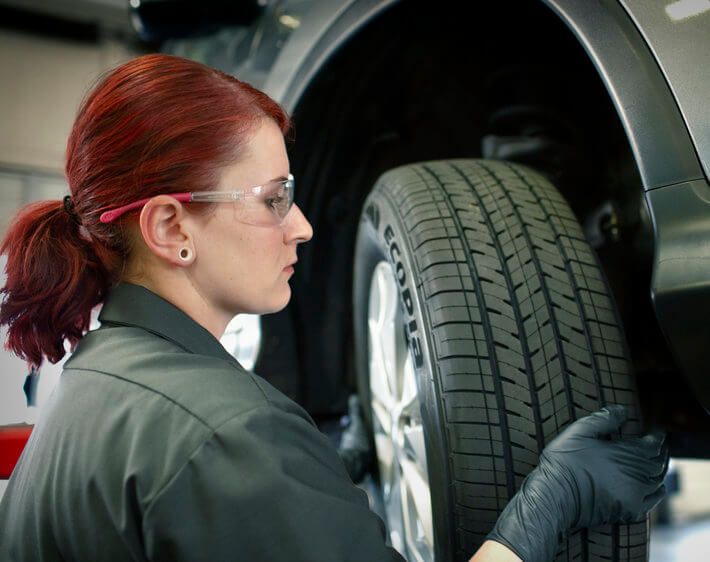Nearly 1 in 5 U.S. drivers don’t know how to change a flat tire, according to AAA. Even for motorists who do know how to change a flat tire, it’s not something that comes as naturally as filling up the gas tank or whipping into a parking spot.
So, whether you’re clueless or just a little rusty, it’s time to get up to speed on fixing a flat. After all, you never know when you might end up stranded along the side of the road with no cell service! Here’s our step-by-step guide to get you and your car back on the road after a flat tire (at least temporarily).
Easy Steps to Change a Flat Tire
1. Find a safe spot.
Once you’re aware that you’ve got a flat tire, don’t brake or turn suddenly. Instead, decrease your speed slowly and look for a place where you can safely pull over to assess the situation. A parking lot or a wide shoulder are two great options.
2. Turn on the flashers.
If you’re still along the side of the road, be sure to turn on your flashing hazard lights so that other motorists are aware of your presence! Hazard lights will help keep you and other motorists safe.
3. Prevent your car from rolling.
After you’ve come to a full stop, apply the parking brake. This way, you can reduce the risk of your car rolling forward or backward while you’re changing the flat tire.
Wheel wedges will also help prevent rolling. If you don’t have wheel wedges, bricks or large stones will do the trick.
If you’re changing a rear tire, place the wedges before the front tires. If you’re changing a front tire, set the wedges behind the rear tires.
4. Consult the owner’s manual.
After you’ve found a safe place to park, put on the hazards, and secured your vehicle, pull out your owner’s manual. Look for vehicle specific instructions for fixing a flat tire. Your vehicle may have unique requirements.
5. Find your spare tire.
The exact location of your spare tire can vary depending on the type of vehicle you drive. In many compact cars, the spare tire is located in the trunk under a latch. Some trucks and SUVs keep the spare tire suspended under the vehicle. Your owner’s manual will tell you where to find your spare tire.
By the way, many cars don’t have spare tires, according to AAA. If your car doesn't have one, visit your local Firestone Complete Auto Care as soon as you can to learn more about spare tire options and prepare for an emergency.
6. Look for the required tools.
If your car came with a spare tire, then it also likely came equipped with two tools you’ll need—a jack and a lug wrench. Check the trunk!
7. Take off the hubcap or wheel cover.
If a hubcap is covering the lug nuts (they’re in a circle at the center of your wheel), take this off before you go any further. In most cases, you can pry off the hubcap with the flat end of a lug wrench. However, you should read the owner’s manual to make sure you don’t need a special tool to do the job.
If the lug nuts are visible, you can move along to the next step.
8. Loosen the lug nuts.
With the lug wrench, twist the lug nuts counter-clockwise. You might need to use your foot or apply your body weight to loosen them, and that’s perfectly fine.
Loosen the lug nuts about one-fourth to one-half of a turn. Don’t take them off yet. It's important to loosen them before raising the car on the jack.
9. Position the jack under the car.
But where? Usually, the jack should go under the vehicle, next to the flat tire. Most car frames have a particular indented area that’s designed to accommodate the jack. Feel for it and make sure the placement is sturdy. Your owner’s manual may specify exactly where to put the jack, so this is a great time to double check.
10. Lift the car with the jack.
Once the jack is in the correct place, use it to lift the car about 6 inches off the ground. Jacks can vary, so make sure you’re using your jack correctly and following the instructions.
Warning: Keep your hands, feet, and other body parts away from the bottom of the car during or after the process of lifting up the vehicle with the jack!
11. Remove the lug nuts.
It's time to take off the lug nuts. At this stage, you should be able to twist them off with your fingers.
12. Take off the flat tire.
Grab the tire by the treads and ease it toward you until it’s entirely free from the wheel hub. To prevent it from rolling away, place the tire on its side.
13. Put on the spare.
Get the spare tire and put it on the wheel hub by aligning the rim with the lug bolts. Ease the tire onto the car until the lug bolts are visible through the rim.
14. Screw on the lug nuts.
Place the lug nuts on the lug bolts and screw them on by hand, but do not tighten with a wrench. Work in a star-shaped or criss-cross pattern, starting with the top lug nut then moving to the nut that is almost directly opposite from the one that you just tightened. Working in this pattern helps in two ways. One, it helps the lug nuts stay correctly placed when they're tightened with the wrench, and two, it reduces the likelihood of a wobbly wheel.
15. Ease the car back toward the ground.
Partially lower the car so that the spare is on the ground, but the full weight of the vehicle isn’t resting on the tire. This is when you’ll want to make sure the lug nuts are as tight as possible by screwing them on clockwise with the wrench. Once again, you might need to use some force to do this.
16. Completely lower the car.
Now, it’s time to lower the car all the way to the ground and remove the jack. Check the lug nuts one last time to make sure they’re as tight as you can make them.
17. Put on the hubcap.
If you had to remove a hubcap, put it back on now. Store the hubcap in your car if it won’t fit over the spare tire.
18. Check the tire pressure.
Check the pressure in the spare to see whether it has an adequate amount of air. Temporary spare tires typically require 60 psi. If the tire pressure is low, slowly drive to a Firestone Complete Auto Care or other service station.
19. Pack up your tools.
Look around you. Make sure you’ve stashed the jack, lug wrench, wheel wedges, flat tire, and hubcap (if applicable) in your car. Also, make sure you remember to release the parking brake before you take off!
20. Visit a tire pro.
Spare tires are meant to be temporary. In other words, you shouldn’t be traveling long distances or at high speeds if you’re still driving on a spare. A trained technician at Firestone Complete Auto Care will be able to tell you whether your flat tire can be repaired or needs replacement.
If you never want to get stuck on the side of the road changing a flat tire again, ask a tire technician at your local Firestone Complete Auto Care about DriveGuard tires. DriveGuard tires can take a puncture and still drive up to 50 miles at speeds of up to 50 MPH. Can you say the same about your current tires?



